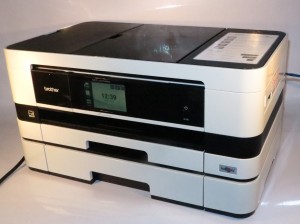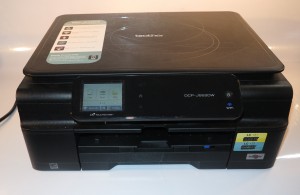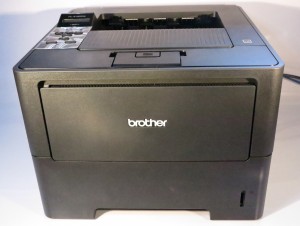Your existing printer or multifunction unit may be working satisfactorily for you at the moment but you may find that you or your household may benefit from a secondary printer that is connected to your home network.
Typically this may be brought about by you buying a printer with more functionality than the one you already own and you “pushing” down the existing printer to serve as a secondary machine like you would with the existing refrigerator or colour television set. In some cases, it is more attractive to do this with mid-tier consumer units or any of the business units where you spend more on the equipment rather than those units that cost as much as you paid for the machine to replace their ink or toner cartridges.
Of course, the idea of networking a printer would be to avoid the need to buy a printer for each computer at home but a different trend has risen. Increasingly, most printer manufacturers are implementing a “mobile-printing” strategy to allow you to print from a smartphone or tablet. This can be done through Apple AirPrint for iOS devices, Google CloudPrint for some Android devices or a manufacturer-provided app.
Similarly, most printer manufacturers are selling equipment on a “horses-for-courses” approach where different printers in their consumer and small-business product ranges suit different tasks.
What applications may cause you to think of a secondary printer?
There are two main applications where a secondary printer on your home network may be handy
A machine more locally placed
Most likely, you will have the printer kept in your home office or study where you do a lot of the computing. But, as you use AirPrint or similar features that enable printing from your tablet or smartphone, you may be wanting to order print jobs from other rooms in the house like the kitchen. Similarly, most of the recent crop of printers have a “print-from-Web” function to obtain hard copy from Web services like Dropbox or Facebook.
The idea behind this setup is that when your computer device asks you which printer to send the job to, you determine the machine that is local to you for that job. Here, you have the advantage of being ready to collect the job immediately rather than it piling up on the desk. You also have the assurance of hearing whether the machine has started to turn out your job or not so you are not worried about sending it to the wrong unit or mis-specifying that job.
This situation may be more real for those of you who live in a larger house or a multi-storey / split-level house and have the home office up the front or downstairs but have a significant activity area on the other side of the house or upstairs like the kitchen and family room that is located down the back of the house. Similarly, those of you who have a multi-building home network covering the garage,barn or bungalow alongside the main house may also find this situation applying to you. Here, you could keep a lesser-capable printer or multifunction in the bungalow while having another unit like a better model kept in the main house.
Here, you could keep a light-duty network-capable multifunction printer like the Brother DCP-J552DW, the Brother DCP-J562DW or HP Envy 120 in the kitchen or family room. This could allow you to do on-the-spot printing and copying in that area. A mid-tier consumer inkjet, low-tier business inkjet or a low-tier business laser / LED machine may work well for a study.
Some families may use this as a way to work towards providing their adolescent or adult child with a printer for when they “grow their wings and leave the family nest”. Here, the adolescent or adult child could be responsible for buying the consumables for that machine and then take it with them when they move onwards.
The ability to have complementary functionality
You could have the best of both printing types for your home office if you have both a laser and an inkjet printer. Here, you could benefit from the flexibility that this offers when it comes to choosing and using stationery for your printing requirements. An example of this could be to not worry about purchasing laser labels or inkjet labels for your envelopes because you can use the appropriate machine for the labels you have on hand.
Some users may benefit from a monochrome laser or LED unit for their routine document-printing needs while a colour inkjet can come in handy when occasional colour printing is required. Similarly, a photo-grade inkjet machine like a high-end HP Photosmart or OfficeJet or high-end Epson could serve your photographic or brochure-printing needs while a machine not so good with “presentation printing” or “photo-grade printing” can do the normal office printing work. This is more so as presentation-grade glossy or silk-look paper is more readily available at local office-supply stores for inkjet printers than it is for laser printers.
Another example would be is having machines that handle different paper sizes such as A4 and A3. You could use an A3-capable printer or MFC for your large-sheet printing requirements while you maintain an A4-capable machine like most business lasers for most printing needs.
What must you consider?
A common issue associated with very-low-end printers when it comes to keeping them going is that the cost of purchasing replacement consumables is equivalent to that of purchasing a similar-standard printer. As well, a lot of these machines may not last for a long time nor would they be able to yield a significant number of pages.
I would also be careful of the two-cartridge colour inkjet printers because if one colour runs out, you would have to replace the colour cartridge. These can only work well for occasional work but I wouldn’t expect to run them hard for constant work.
On the other hand, I would pay attention to brands that use the same type of consumables across a large part of their product range. This is represented with Hewlett-Packard implementing the 564 series of ink cartridges across most of their Photosmart product range since 2009 and Brother using the LC-133 cartridges across all of their current-issue inkjet machines.
The latter example was underscored with the Brother DCP-J552DW multifunction printer which is a light-duty home machine and the Brother MFC-J6720DW A3 multifunction printer which is a heavy-duty SOHO unit using these cartridges – you don’t have to think of buying two different cartridge types for the different printers..
Conclusion
You can run one or more additional printers on your home network still as communal printers. But these can earn their keep either as a machine that is local to a point of activity and/or to provide functionality that is complementary to other printers that you own.





